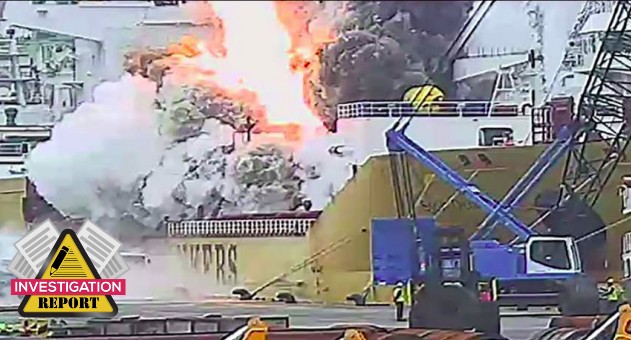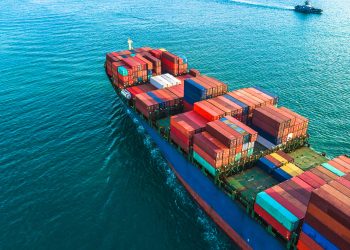UK MAIB issued an investigation report on the cargo tank explosion and fire onboard the chemical tanker Stolt Groenland in September 2019. The investigation stressed that heat transfer from other cargoes was not fully appreciated and that the styrene monomer temperature was not monitored.
The incident
On 28 September 2019, a cargo tank containing styrene monomer onboard the Cayman Islands-registered chemical tanker ‘Stolt Groenland’ ruptured causing an explosion and fire. The tanker was moored alongside a general cargo berth in Ulsan, Republic of Korea and the Singapore registered chemical tanker Bow Dalian was moored outboard.
The ignition of the styrene monomer vapour resulted in a fireball, which reached the road bridge above. Both vessels were damaged, and two crew suffered minor injuries. Fifteen emergency responders were injured during the fire-fighting, which lasted for over 6 hours.
Probable causes
The rupture of the styrene monomer tank resulted from a runaway polymerization that was initiated by elevated temperatures caused by heat transfer from other chemical cargoes. The elevated temperatures caused the inhibitor, added to prevent the chemical’s polymerization during the voyage, to deplete more rapidly than expected.
Although the styrene monomer had not been stowed directly adjacent to heated cargo, the potential for heat transfer through intermediate tanks was not fully appreciated or assessed. Critical temperature limits had been reached before the vessel berthed under the road bridge in Ulsan.
The tanker’s crew did not monitor the temperature of the styrene monomer during the voyage, and therefore were not aware of the increasingly dangerous situation.
[smlsubform prepend=”GET THE SAFETY4SEA IN YOUR INBOX!” showname=false emailtxt=”” emailholder=”Enter your email address” showsubmit=true submittxt=”Submit” jsthanks=false thankyou=”Thank you for subscribing to our mailing list”]
A similar dangerous styrene monomer polymerization incident had occurred a couple of weeks earlier onboard another Stolt Tankers B.V. ship, Stolt Focus. The heat generated by the polymerization process was noticed before the critical runaway temperature was reached. The styrene monomer cargoes onboard both tankers was loaded at a similar time from the same tank in Houston and were exposed to similar environmental conditions. The incident onboard Stolt Focus was not reported to the ship’s Flag State or other masters in the Stolt Tankers B.V. feet.
Conclusions
- The explosion and fire onboard Stolt Groenland resulted from the runaway polymerization of the styrene monomer cargo in cargo tank 9S.
- The polymerization of the styrene monomer in 9S was initiated by the cargo’s elevated temperature for much of the voyage, which reduced the effectiveness of the TBC inhibitor.
- The elevated temperature of the styrene monomer in 9S resulted from the transfer of heat from the HMD cargo in the port side tanks, via the adiponitrile cargo in 9C.
- The precaution of not stowing the styrene monomer next to the heated HMD cargo was not sufficient in meeting the adequate segregation requirement of the IBC Code.
- The probability of heat being transferred from the HMD cargo tanks to the styrene monomer cargo was not fully considered during the planning and approval of the cargo stowage.
- Calculations to predict heat transfer during cargo stowage planning were not conducted because they were complex and outside the capabilities of the ship operator and the tanker’s crew. They were also outside the scope of the cargo stowage software.
- Instructions and guidance were clear that inhibited cargoes should not be stowed adjacent to heated cargoes, but the likelihood of heat transfer through adjacent or intermediate cargo tanks was not covered in detail.
- Despite being a requirement in Stolt Groenland’s SMS, the temperature of the styrene monomer was not monitored, and the temperature alarms available on the cargo monitoring system were not set. The crew also either did not notice or did not recognize the significance of, the elevated temperatures of the cargoes discharged in Kobe and Ulsan.
- The absence of temperature monitoring of the styrene monomer was influenced by the crew’s view that it was a benign cargo when inhibited and that no previous problems or difficulties with its carriage had been experienced.
Actions taken
-MAIB Actions
The MAIB has issued an interim report that alerted the chemical tanker industry to the circumstances of the accident and requested information about previous similar accidents or incidents.
-Stolt Tankers B.V. has:
- Issued feet notices highlighting issues with inhibited cargo carriage.
- Introduced a requirement for ships to report cargo temperatures to the ship operator ashore three times per week.
- Revised procedures for the setting of cargo-related alarms.
- Enhanced procedures for the checking of cargo stowages that contain both heated and inhibited cargoes.
- Commenced a concerted campaign through its marine compliance officers to raise crew awareness of inhibited cargoes.
- Started to investigate the possibility of upgrading its cargo stowage software to calculate and predict heat transfer within a stowage containing both heated and heat-sensitive cargoes.
- Started to work with manufacturers and industry bodies to ensure that cargo handling instructions and protocols for inhibited cargoes are practical and achievable.
- Investigated the use of polymer testing equipment on board ships. Unfortunately, it was not considered a viable prospect with current technology.
-The Ministry of Oceans and Fisheries, Republic of Korea has prohibited ship-to-ship transfer operations for dangerous cargo on general cargo berths in Ulsan.
-The ICS has amended the Tanker Safety Guide (Chemicals), published January 2021, section 6.3.4 Stowage planning, to make it clear that:
- The stowage of heated and inhibited cargoes can result in a dynamic situation in which the degree of heat transfer may be complex and difficult to predict.
- One tank separation between heated and heat-sensitive cargoes might not be sufficient.
The Chemical Distribution Institute has instigated the production of a best practice paper regarding the dosing of ship cargo tanks which will address, among other things, inhibitor quantity validation.
Recommendations
-Cayman Island Shipping Registry, through the UK as the Member Government for the Red Ensign Group to the IMO, is recommended to propose to the IMO a revision to Section 15.13 of the IBC Code to:
- Include in the certificate of protection the actions to be taken in the event of a cargo falling outside of the manufacturer’s specified oxygen and temperature limits, and that
- Any actions should be realistic, taking account of the limitations on board ships regarding the monitoring, adding, and mixing of inhibitor during the voyage.
-ICS is recommended to promulgate this report to its members.
-INTERTANKO is recommended to promulgate this report to its members.
-Chemical Distribution Institute is recommended to amend its publication ‘Chemical Tanker Operations for the STCW Advanced Training Course – A Practical Guide to Chemical Tanker Operations’ to make it clear that:
- The stowage of heated and inhibited cargoes can result in a dynamic situation in which the degree of heat transfer may be complex and difficult to predict.
- One tank separation between heated and heat sensitive cargoes might not be sufficient.
- Promulgate this report to its members.
-Plastics Europe (Styrene Producers Association) is recommended to work with its members to incorporate the lessons learned from this accident in its Styrene Monomer: Safe Handling Guide.
-Stolt Tankers B.V. is recommended to share with INTERTANKO the circumstances and lessons learned from the Stolt Focus incident and the results of its research into improved stowage software, to enable prediction of heat transfer and cargo behavior.






























































